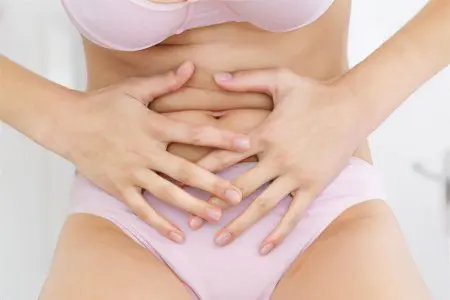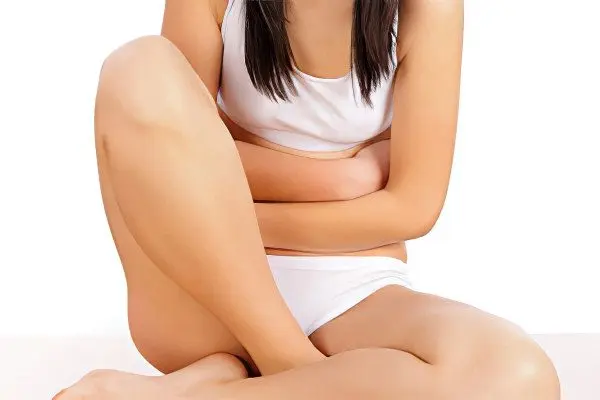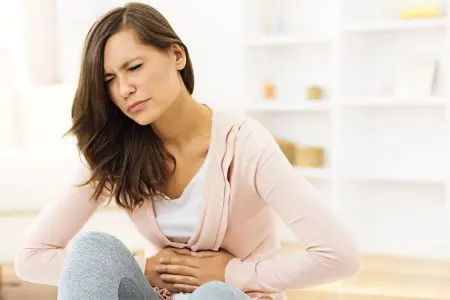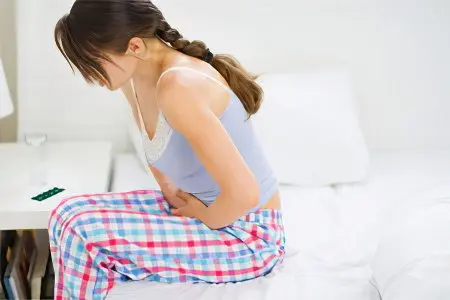Contents
At a gynecologist’s appointment, the most common complaint of women is a complaint of pain in the lower abdomen. Such pain can indicate not only problems in the genital area, but also diseases of the nervous system, as well as acute surgical pathology. It is impossible to endure severe pain in the lower abdomen, it is necessary to consult a doctor as soon as possible and undergo an examination.
Causes of pain in the lower abdomen in women

Organic causes of pain in women in the lower abdomen:
Pathologies of the organs of the reproductive system. These can be diseases such as: inflammation or apoplexy of the ovaries, endometriosis, ovarian cyst or torsion of its legs, uterine fibroids.
Pain can be triggered by an intrauterine device, if any, in a woman’s body.
Pathologies requiring surgical intervention, such as appendicitis.
Acute inflammatory diseases of the gallbladder, such as cholecystitis.
Damage to the organs of the urinary system: inflammation of the kidneys or bladder.
Pain can occur during pregnancy, for example, when there is a threat of miscarriage, with the development of an ectopic pregnancy, with early placental abruption, after an abortion.
Functional causes that can provoke the occurrence of abdominal pain:
Menstrual irregularities and dysfunctional uterine bleeding.
Ovulation.
Stagnation of menstrual blood after curettage, or when the uterus is bent.
Pain can vary in intensity and duration.
Inflammation of the uterus, ovaries and fallopian tubes. The inflammatory process manifests itself with a sharp increase in body temperature, the appearance of intense pain in the lower abdomen. In parallel, the symptoms of intoxication are increasing.
Inflammation of the ovaries and fallopian tubes is expressed in severe pain, which is localized in the left or right side, in the lower abdomen. During a gynecological examination, the doctor palpates painful appendages.
If a woman develops endometritis, then the pain is localized in the center of the abdomen. With the help of palpation, a painful and enlarged uterus is detected.
If the inflammation of the appendages or endometrium of the uterus is chronic, then the pains are not acute, but aching, they occur with a certain frequency. The uterus thickens, responds with increased sensitivity to touch.
To stop inflammation, a woman is prescribed a course of antibiotic therapy, infusion treatment, taking vitamin complexes, and local treatment using vaginal suppositories.
Endometriosis. Endometriosis is the growth of uterine endometrial cells in abnormal locations. Pain with endometriosis appears before the start of the next menstruation, and during bleeding they become very intense.
The location of the pain depends on where exactly the endometrium has grown:
Endometriosis of the uterus – pain is localized in the center of the lower abdomen.
Endometriosis of the appendages – the pain is concentrated in the groin.
Retrocervical endometriosis – pain is localized behind the pubis.
The stronger the growth of the endometrium, the more intense the pain. Other symptoms of pathology: violations of the timing of the menstrual cycle, a change in the nature of menstrual flow, the inability to conceive a child.
To get rid of endometriosis, it is necessary to undergo treatment with hormonal drugs. Sometimes the help of a surgeon is required.
Apoplexy of the ovary. In the middle of the cycle, hemorrhage in the ovary may occur. In this case, the main follicle is torn, the vessels of the ovary are damaged, internal bleeding develops. Blood enters the peritoneal cavity, fallopian tubes and uterus.
Apoplexy can occur against the background of intimacy, with severe physical exertion. The woman begins to experience severe pain in the lower abdomen, which are localized on the side where the damaged ovary is located. In parallel, there is a sharp drop in blood pressure, the skin becomes pale, fainting is possible.

Taking any drugs in this situation is not advisable, surgical intervention is necessary.
Myoma of the uterus. When the neoplasm reaches an impressive size, a woman experiences pain, as the tumor begins to put pressure on neighboring organs and tissues, to pinch the nerve endings.
The pain is aching and dull. When the birth of a myomatous node occurs, the pain proceeds according to the type of contractions, it becomes very intense. In parallel, bleeding opens.
Cystic tumor of the ovary with torsion of its stem. Torsion of the leg of the cyst can provoke physical exertion, sudden movements, deep torso bends. If the angle of torsion is greater than 90 °C, then there is a violation of the venous outflow of the cyst, it increases in size. At the same time there are aching pains.
If there was a complete torsion, then the cyst begins to suffer from a pronounced violation of the blood supply. A woman at this time experiences severe pain, signs of intoxication of the body begin to increase, body temperature increases. In this case, only surgical intervention can help, and you need to seek medical help immediately.
Inflammation of the appendix. Appendicitis is characterized by pain in the abdomen. First, they are localized in the upper abdomen, in its center, and then move to the right side. In addition, a person’s body temperature rises, weakness increases, the desire to eat disappears. If the patient is not urgently hospitalized and operated on, then he will develop inflammation of the peritoneum, which will lead to death.
Inflammation of the gallbladder. Most often, the cause of the inflammatory reaction is the presence of stones in the cavity of the organ. The disease begins acutely, a person’s body temperature rises, nausea appears, and vomiting may occur. Since the level of bilirubin in the blood becomes very high, this provokes the appearance of skin itching. The pains are localized on the right side, under the ribs, they also radiate to the lower abdomen, lower back, back and subclavian region. After a person eats, the pain becomes stronger. To stop inflammation, you will need to follow a sparing diet and take drugs aimed at normalizing the outflow of bile. If the stones are very large, surgery may be required.
Inflammation of the kidneys and bladder. With cystitis, the pain is sharp, very sharp, localized in the pubic area. They become especially intense during the emptying of the bladder.
If the patient has inflammation of the kidneys, then the pain is concentrated in the lumbar region and in the lower abdomen.
Both with cystitis and pyelonephritis, an increase in body temperature and a violation of the outflow of urine are possible.
To stop the inflammatory process, antibiotics and nitrofurans are required.
Ectopic pregnancy. When the fetal egg does not reach the uterus, but is attached to the tubes, the woman has pain in the groin area. As the embryo grows, they begin to disturb more and more often. If an ectopic pregnancy was not diagnosed in time, then an appendage rupture will occur. At the same time, internal bleeding opens, sharp pains appear with irradiation to the vagina and rectum. Treatment is surgical only.
To suspect an ectopic pregnancy, you need to focus on the following signs: a positive pregnancy test, the absence of menstrual bleeding, the appearance of blood from the vagina after another bout of pain.
Pain before and after menstruation

Pain before the onset of menstruation can be triggered by the following reasons:
Algodysmenorrhea, which is most often observed at a young age.
PMS.
Death of the uterus.
Inflammation of the organs located in the pelvis.
If pain occurs after the end of menstruation, then the presence of an endometrioid cyst or chronic endometritis can be suspected.
ovulation and pain
As a rule, when ovulation occurs, most women experience pain. However, it has a low intensity and does not cause a pronounced disturbance of well-being. Painful sensations do not last more than 2 days and may be accompanied by the release of a small amount of blood. No therapy is required.
Pain in the lower abdomen after intimacy

Frustration after intimacy is a fairly common occurrence. A woman does not receive moral satisfaction from intimacy, which leads to pulling pains.
Other causes of pain after intercourse:
Chronic inflammation of the appendages.
Chronic inflammation of the endometrium of the uterus.
Inflammation of the cervix.
Rough actions of the partner, which led to damage to the integrity of the vaginal wall.
Endometriosis.
The presence of tumor growths.
Pregnancy and abdominal pain
During pregnancy, pain in the lower abdomen may indicate that there is a threat of interruption. This can happen before 22 weeks of pregnancy. In addition to pain, blood may appear from the genital tract. A woman with a threatened miscarriage is shown emergency hospitalization.
Placental abruption in the early stages can cause pain in the lower abdomen. In addition, bleeding develops. This situation calls for an emergency caesarean section.

The stomach may start to hurt suddenly, and the cause of the pain will not depend on the menstrual cycle. In this case, one of the following pathologies can be suspected:
Salpingoophoritis or inflammation of the uterine appendages. Pain is localized in the lower abdomen, and discharge from the vagina appears with impurities of pus. Also, the pain may increase after intimacy. Other symptoms of inflammation: an increase in body temperature, general weakness, increased sweating, increased tone of the abdominal muscles, pain during urination. Salpingo-oophoritis is caused by pathogenic microorganisms. If you ignore the disease, it threatens with serious health problems.
Torsion of the appendix. Pain during torsion of the appendage is localized in the lower abdomen, can be given to the lower back. Other signs of torsion: palpable induration in the lower abdomen, nausea and vomiting, pain relief with a change in body position. The most common cause of torsion is adhesions.
Previous abortion. Pain in the lower abdomen is expected if a woman has had an abortion. It occurs as soon as the action of the analgesic ends. Normally, the pain should not be too intense and after a few days they completely disappear. If this does not happen, then you should immediately consult a doctor. Abortion is always associated with a high risk of complications, which must be promptly identified and eliminated. In addition to pain, a woman may experience spotting from the genital tract, the menstrual cycle may fail, and the body temperature may increase.
Rupture of the cyst. Severe pain in the lower abdomen may be due to a ruptured cyst. This process is accompanied by nausea, vomiting, increased weakness. Increased body temperature is not eliminated by taking antipyretic drugs.
Cancers of the uterus. With uterine cancer, the pain is monotonous, appears periodically, so the woman gets used to it. In parallel, there may be vaginal discharge that has an unpleasant odor, as well as intermenstrual bleeding.
Cancers of the ovaries. Drawing pain in the lower abdomen, which bothers for a long time, may be a symptom of ovarian cancer. In addition to pain, there may be an increase in the size of the abdomen, as well as the occurrence of bleeding between menstrual cycles.
Soldering process. Pain in the lower abdomen, fever, nausea, weakness and vomiting – all of these symptoms may indicate the presence of adhesions. These are strands of connective tissue that grow between adjacent organs. With adhesions, varicose veins of the pelvic organs are often observed, which provokes increased pain.
What to do if a woman’s lower abdomen hurts?

An ambulance should be called immediately if the pain is acute and severe. Until such time as the doctors arrived at the scene, you should refrain from taking any painkillers. If the pain is very difficult to endure, then it is permissible to drink 2 No-shpy tablets. This will reduce muscle spasm. While waiting for the doctors, you need to lie on the bed, open the window. Cold helps relieve pain. To do this, you can put a bottle of ice water on your stomach. Any heating is not allowed.
If the pain is present on an ongoing basis, then you should consult a doctor and undergo an examination. The doctor will prescribe a treatment that will need to be followed. To help reduce pain allows an infusion on aspen buds, which is taken 5 times a day, 2 tbsp. l.
To minimize the risk of pain in the lower abdomen, you need to adhere to the following recommendations:
Support the immune system, take vitamin and mineral complexes.
Follow the rules of intimate hygiene.
Do sport.
Undertake preventive examinations in medical institutions.
To refuse from bad habits.
Spend more time outdoors.
It is impossible to endure pain in the abdomen, and when they appear, you should seek help from a specialist.









